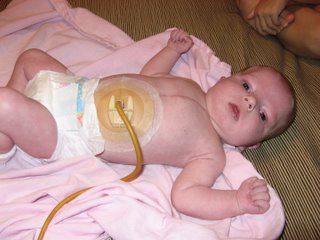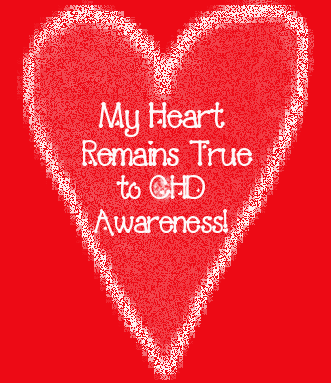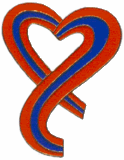
 Well I couldn't blog without showing you life with the g-tube. The picture on top shows the incision site where they inserted the foley g-tube. They have kept this on for 6-8 weeks post op to give the track to her stomach time to heal. When we went back in for follow up last week, the tube was hanging on by a few stitches, so the nurse put this hollister bandage over the tube securing it in place until we can have the foley tube replaced with the button I talked about earlier in the blog. They will do the button on Oct. 10th. They are confident that the stomach track will be fully healed by then. There will be no love lost between me and the foley tube. It's no fun to work with at all because it's leaky, gets clogged at times, and it catches on everything and then tugs on Bryn's stomach. And honestly, it's a little strange seeing a tube coming out of your child's stomach. I'm sure this balloon button thing isn't going to be much better to look at, but it's very low-profile and only protudes about the skin about 1 inch. I'll be sure to post a picture of the "button" after it's inserted into her.
Well I couldn't blog without showing you life with the g-tube. The picture on top shows the incision site where they inserted the foley g-tube. They have kept this on for 6-8 weeks post op to give the track to her stomach time to heal. When we went back in for follow up last week, the tube was hanging on by a few stitches, so the nurse put this hollister bandage over the tube securing it in place until we can have the foley tube replaced with the button I talked about earlier in the blog. They will do the button on Oct. 10th. They are confident that the stomach track will be fully healed by then. There will be no love lost between me and the foley tube. It's no fun to work with at all because it's leaky, gets clogged at times, and it catches on everything and then tugs on Bryn's stomach. And honestly, it's a little strange seeing a tube coming out of your child's stomach. I'm sure this balloon button thing isn't going to be much better to look at, but it's very low-profile and only protudes about the skin about 1 inch. I'll be sure to post a picture of the "button" after it's inserted into her.Notice Brynlyn's fists. In almost all pictures, she has her fist tightly shut. The nurses in the PICU told us that this is actually a "heart baby" thing. Most heart babies tightly clench their fists but what's different than other babies, is that their thumb is tucked inside their fist. It's just very interesting to notice.









































2 comments:
You are so good to share all of this with us. I am nominating you for "Nurse of the Year"! You utterly amaze me.
Wow!
Jenn
Hey Suzie, glad to hear the latest on Brynlyn! I hadn't heard anything in a while and was worried to ask and hear bad news. I'm so happy she's home! What a trial of your faith! My goodness, all you guys are going through... Good luck, you're in our prayers.
Love,
Amie and Danny
Post a Comment